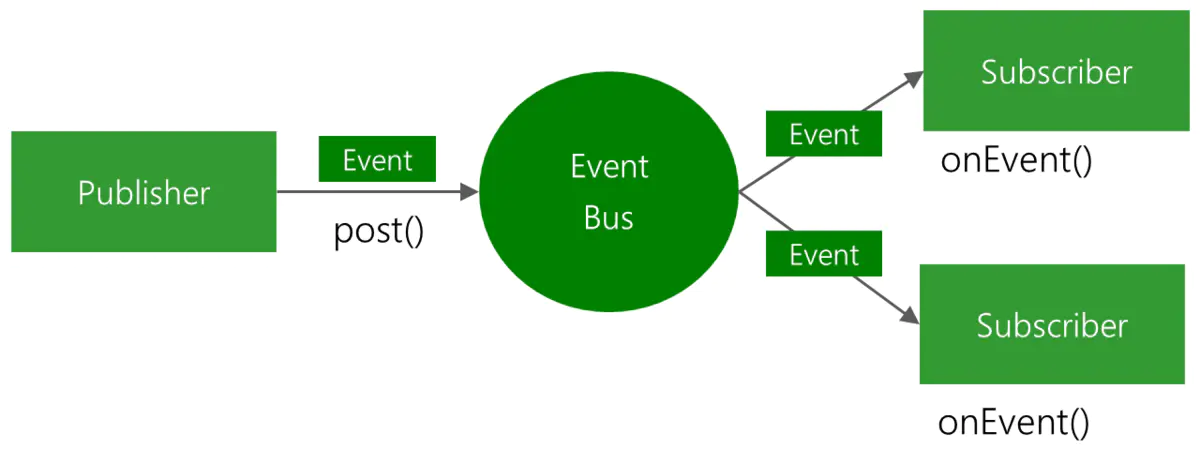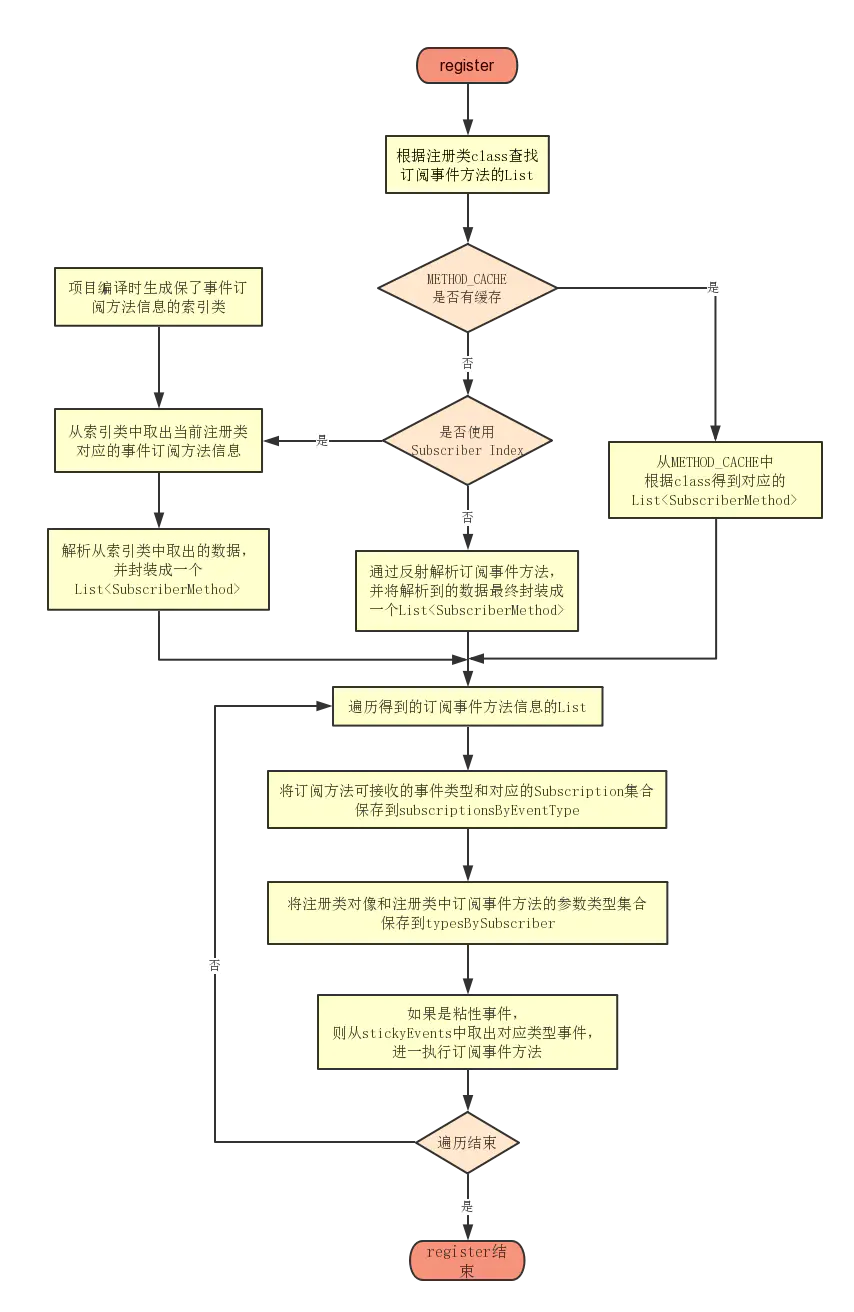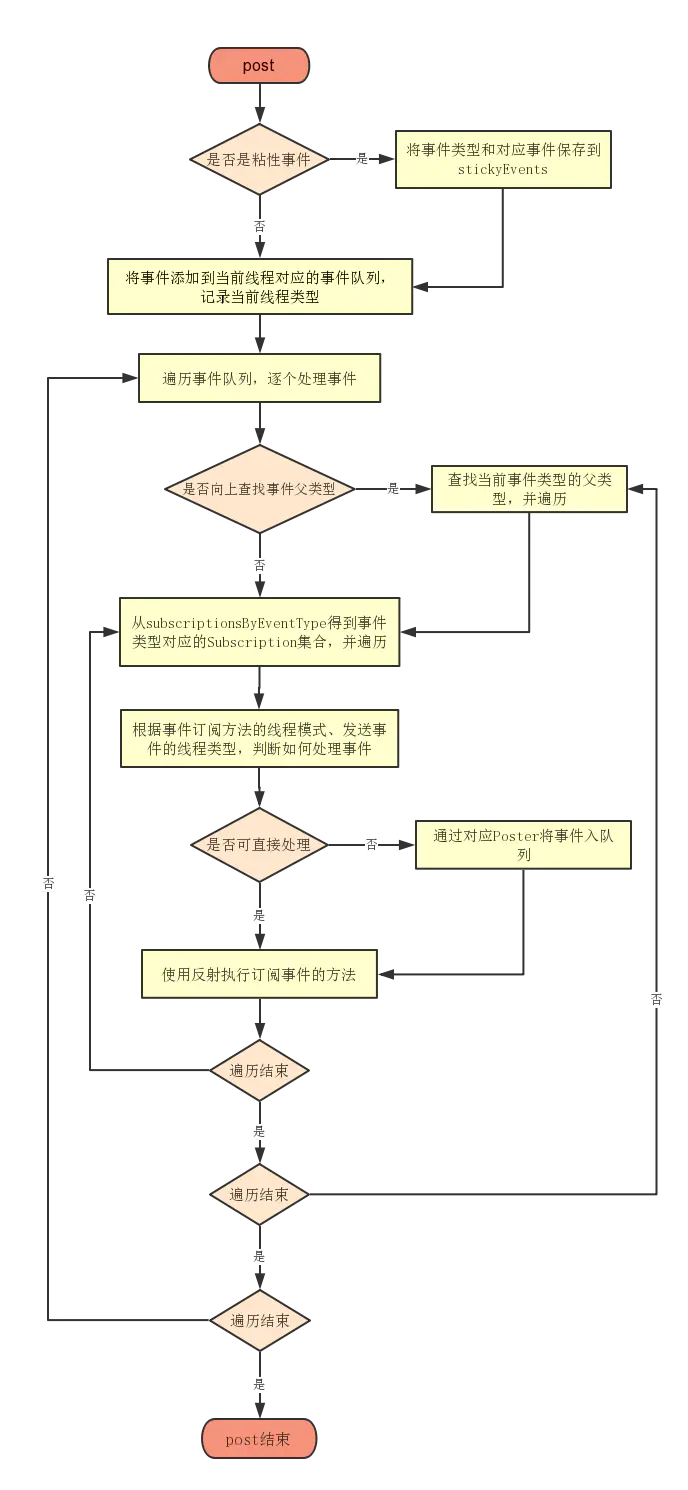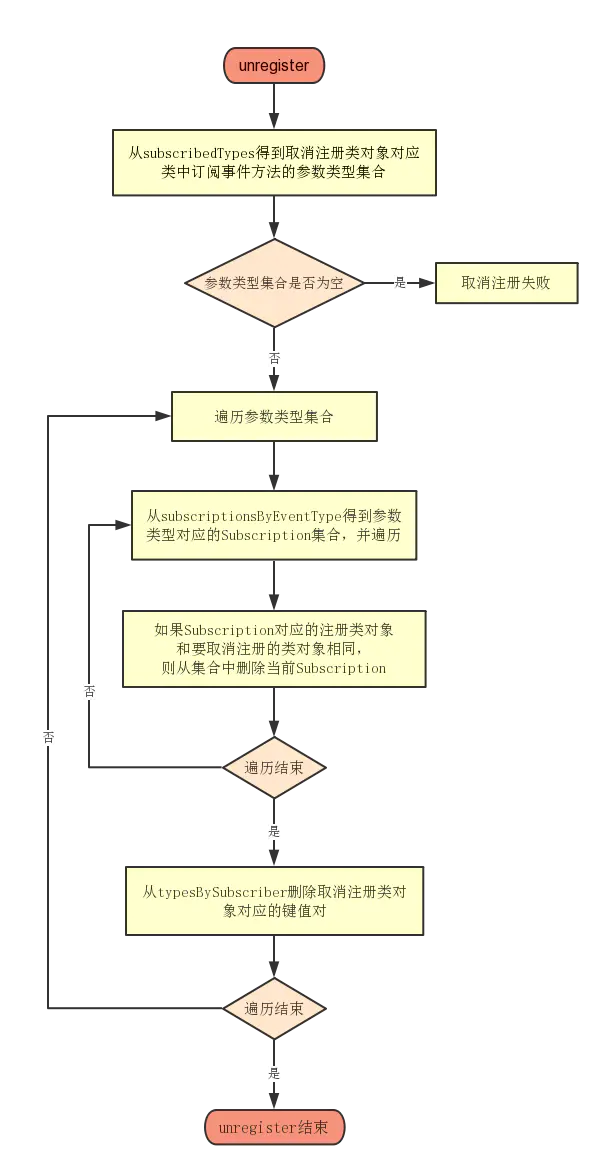Android 开发框架 EventBus 原理解析
EventBus是一款在Android开发中使用的发布/订阅事件总线框架。基于单例+观察者模式,将事件的接收者和发送者分开,简化了组件之间的通信。其原理图如下:

此框架的使用方式,我们在 https://www.cnblogs.com/renhui/p/10868392.html 里面已经讲过了,这里不多赘述了,下面我们讲一下其原理。
一、EventBus 注册订阅方法
注册订阅需要调用:
EventBus.getDefault().register(this);
这里的getDefault()方法是一个单例方法,保证当前只有一个EventBus实例 :
public static EventBus getDefault() { if (defaultInstance == null) { synchronized (EventBus.class) { if (defaultInstance == null) { defaultInstance = new EventBus(); } } } return defaultInstance; }
获取到EventBus实例就能进行注册了:
public void register(Object subscriber) { // 得到当前要注册类的Class对象 Class<?> subscriberClass = subscriber.getClass(); // 根据Class查找当前类中订阅了事件的方法集合,即使用了Subscribe注解、有public修饰符、一个参数的方法 // SubscriberMethod类主要封装了符合条件方法的相关信息: // Method对象、线程模式、事件类型、优先级、是否是粘性事等 List<SubscriberMethod> subscriberMethods = subscriberMethodFinder.findSubscriberMethods(subscriberClass); synchronized (this) { // 循环遍历订阅了事件的方法集合,以完成注册 for (SubscriberMethod subscriberMethod : subscriberMethods) { subscribe(subscriber, subscriberMethod); } } }
可以看到register()方法主要分为查找和注册两部分,首先来看查找的过程,从findSubscriberMethods()开始:
List<SubscriberMethod> findSubscriberMethods(Class<?> subscriberClass) { // METHOD_CACHE是一个ConcurrentHashMap,直接保存了subscriberClass和对应SubscriberMethod的集合,以提高注册效率,赋值重复查找。 List<SubscriberMethod> subscriberMethods = METHOD_CACHE.get(subscriberClass); if (subscriberMethods != null) { return subscriberMethods; } // 由于使用了默认的EventBusBuilder,则ignoreGeneratedIndex属性默认为false,即是否忽略注解生成器 if (ignoreGeneratedIndex) { subscriberMethods = findUsingReflection(subscriberClass); } else { subscriberMethods = findUsingInfo(subscriberClass); } // 如果对应类中没有符合条件的方法,则抛出异常 if (subscriberMethods.isEmpty()) { throw new EventBusException("Subscriber " + subscriberClass + " and its super classes have no public methods with the @Subscribe annotation"); } else { // 保存查找到的订阅事件的方法 METHOD_CACHE.put(subscriberClass, subscriberMethods); return subscriberMethods; } }
findSubscriberMethods()流程很清晰,即先从缓存中查找,如果找到则直接返回,否则去做下一步的查找过程,然后缓存查找到的集合,根据上边的注释可知findUsingInfo()方法会被调用:
private List<SubscriberMethod> findUsingInfo(Class<?> subscriberClass) { FindState findState = prepareFindState(); findState.initForSubscriber(subscriberClass); // 初始状态下findState.clazz就是subscriberClass while (findState.clazz != null) { findState.subscriberInfo = getSubscriberInfo(findState); // 条件不成立 if (findState.subscriberInfo != null) { SubscriberMethod[] array = findState.subscriberInfo.getSubscriberMethods(); for (SubscriberMethod subscriberMethod : array) { if (findState.checkAdd(subscriberMethod.method, subscriberMethod.eventType)) { findState.subscriberMethods.add(subscriberMethod); } } } else { // 通过反射查找订阅事件的方法 findUsingReflectionInSingleClass(findState); } // 修改findState.clazz为subscriberClass的父类Class,即需要遍历父类 findState.moveToSuperclass(); } // 查找到的方法保存在了FindState实例的subscriberMethods集合中。 // 使用subscriberMethods构建一个新的List<SubscriberMethod> // 释放掉findState return getMethodsAndRelease(findState); }
findUsingInfo()方法会在当前要注册的类以及其父类中查找订阅事件的方法,这里出现了一个FindState类,它是SubscriberMethodFinder的内部类,用来辅助查找订阅事件的方法,具体的查找过程在findUsingReflectionInSingleClass()方法,它主要通过反射查找订阅事件的方法:
private void findUsingReflectionInSingleClass(FindState findState) { Method[] methods; try { // This is faster than getMethods, especially when subscribers are fat classes like Activities methods = findState.clazz.getDeclaredMethods(); } catch (Throwable th) { // Workaround for java.lang.NoClassDefFoundError, see https://github.com/greenrobot/EventBus/issues/149 methods = findState.clazz.getMethods(); findState.skipSuperClasses = true; } // 循环遍历当前类的方法,筛选出符合条件的 for (Method method : methods) { // 获得方法的修饰符 int modifiers = method.getModifiers(); // 如果是public类型,但非abstract、static等 if ((modifiers & Modifier.PUBLIC) != 0 && (modifiers & MODIFIERS_IGNORE) == 0) { // 获得当前方法所有参数的类型 Class<?>[] parameterTypes = method.getParameterTypes(); // 如果当前方法只有一个参数 if (parameterTypes.length == 1) { Subscribe subscribeAnnotation = method.getAnnotation(Subscribe.class); // 如果当前方法使用了Subscribe注解 if (subscribeAnnotation != null) { // 得到该参数的类型 Class<?> eventType = parameterTypes[0]; // checkAdd()方法用来判断FindState的anyMethodByEventType map是否已经添加过以当前eventType为key的键值对,没添加过则返回true if (findState.checkAdd(method, eventType)) { // 得到Subscribe注解的threadMode属性值,即线程模式 ThreadMode threadMode = subscribeAnnotation.threadMode(); // 创建一个SubscriberMethod对象,并添加到subscriberMethods集合 findState.subscriberMethods.add(new SubscriberMethod(method, eventType, threadMode, subscribeAnnotation.priority(), subscribeAnnotation.sticky())); } } } else if (strictMethodVerification && method.isAnnotationPresent(Subscribe.class)) { String methodName = method.getDeclaringClass().getName() + "." + method.getName(); throw new EventBusException("@Subscribe method " + methodName + "must have exactly 1 parameter but has " + parameterTypes.length); } } else if (strictMethodVerification && method.isAnnotationPresent(Subscribe.class)) { String methodName = method.getDeclaringClass().getName() + "." + method.getName(); throw new EventBusException(methodName + " is a illegal @Subscribe method: must be public, non-static, and non-abstract"); } } }
到此register()方法中findSubscriberMethods()流程就分析完了,我们已经找到了当前注册类及其父类中订阅事件的方法的集合。接下来分析具体的注册流程,即register()中的subscribe()方法:
private void subscribe(Object subscriber, SubscriberMethod subscriberMethod) { // 得到当前订阅了事件的方法的参数类型 Class<?> eventType = subscriberMethod.eventType; // Subscription类保存了要注册的类对象以及当前的subscriberMethod Subscription newSubscription = new Subscription(subscriber, subscriberMethod); // subscriptionsByEventType是一个HashMap,保存了以eventType为key,Subscription对象集合为value的键值对 // 先查找subscriptionsByEventType是否存在以当前eventType为key的值 CopyOnWriteArrayList<Subscription> subscriptions = subscriptionsByEventType.get(eventType); // 如果不存在,则创建一个subscriptions,并保存到subscriptionsByEventType if (subscriptions == null) { subscriptions = new CopyOnWriteArrayList<>(); subscriptionsByEventType.put(eventType, subscriptions); } else { if (subscriptions.contains(newSubscription)) { throw new EventBusException("Subscriber " + subscriber.getClass() + " already registered to event " + eventType); } } // 添加上边创建的newSubscription对象到subscriptions中 int size = subscriptions.size(); for (int i = 0; i <= size; i++) { if (i == size || subscriberMethod.priority > subscriptions.get(i).subscriberMethod.priority) { subscriptions.add(i, newSubscription); break; } } // typesBySubscribere也是一个HashMap,保存了以当前要注册类的对象为key,注册类中订阅事件的方法的参数类型的集合为value的键值对 // 查找是否存在对应的参数类型集合 List<Class<?>> subscribedEvents = typesBySubscriber.get(subscriber); // 不存在则创建一个subscribedEvents,并保存到typesBySubscriber if (subscribedEvents == null) { subscribedEvents = new ArrayList<>(); typesBySubscriber.put(subscriber, subscribedEvents); } // 保存当前订阅了事件的方法的参数类型 subscribedEvents.add(eventType); // 粘性事件相关的,后边具体分析 if (subscriberMethod.sticky) { if (eventInheritance) { // Existing sticky events of all subclasses of eventType have to be considered. // Note: Iterating over all events may be inefficient with lots of sticky events, // thus data structure should be changed to allow a more efficient lookup // (e.g. an additional map storing sub classes of super classes: Class -> List<Class>). Set<Map.Entry<Class<?>, Object>> entries = stickyEvents.entrySet(); for (Map.Entry<Class<?>, Object> entry : entries) { Class<?> candidateEventType = entry.getKey(); if (eventType.isAssignableFrom(candidateEventType)) { Object stickyEvent = entry.getValue(); checkPostStickyEventToSubscription(newSubscription, stickyEvent); } } } else { Object stickyEvent = stickyEvents.get(eventType); checkPostStickyEventToSubscription(newSubscription, stickyEvent); } } }
二、取消注册订阅方法
EventBus提供了取消注册订阅的Api,其调用方式如下:
EventBus.getDefault().unregister(this);
下面我们看一下这个方法是如何取消订阅的:
public synchronized void unregister(Object subscriber) { // 得到当前注册类对象 对应的 订阅事件方法的参数类型 的集合 List<Class<?>> subscribedTypes = typesBySubscriber.get(subscriber); if (subscribedTypes != null) { // 遍历参数类型集合,释放之前缓存的当前类中的Subscription for (Class<?> eventType : subscribedTypes) { unsubscribeByEventType(subscriber, eventType); } // 删除以subscriber为key的键值对 typesBySubscriber.remove(subscriber); } else { logger.log(Level.WARNING, "Subscriber to unregister was not registered before: " + subscriber.getClass()); } }
内容很简单,我们顺着代码继续看,下面是unsubscribeByEventType方法:
private void unsubscribeByEventType(Object subscriber, Class<?> eventType) { // 得到当前参数类型对应的Subscription集合 List<Subscription> subscriptions = subscriptionsByEventType.get(eventType); if (subscriptions != null) { int size = subscriptions.size(); // 遍历Subscription集合 for (int i = 0; i < size; i++) { Subscription subscription = subscriptions.get(i); // 如果当前subscription对象对应的注册类对象 和 要取消注册的注册类对象相同,则删除当前subscription对象 if (subscription.subscriber == subscriber) { subscription.active = false; subscriptions.remove(i); i--; size--; } } } }
可以看出来在unregister()方法中,释放了typesBySubscriber、subscriptionsByEventType中缓存的资源。
三、EventBus 发送事件
当发送一个事件的时候,我们可以通过如下方式:
EventBus.getDefault().post("Hello World!")
可以看到,发送事件就是通过post()方法完成的:
public void post(Object event) { // currentPostingThreadState是一个PostingThreadState类型的ThreadLocal // PostingThreadState类保存了事件队列和线程模式等信息 PostingThreadState postingState = currentPostingThreadState.get(); List<Object> eventQueue = postingState.eventQueue; // 将要发送的事件添加到事件队列 eventQueue.add(event); // isPosting默认为false if (!postingState.isPosting) { // 是否为主线程 postingState.isMainThread = isMainThread(); postingState.isPosting = true; if (postingState.canceled) { throw new EventBusException("Internal error. Abort state was not reset"); } try { // 遍历事件队列 while (!eventQueue.isEmpty()) { // 发送单个事件 // eventQueue.remove(0),从事件队列移除事件 postSingleEvent(eventQueue.remove(0), postingState); } } finally { postingState.isPosting = false; postingState.isMainThread = false; } } }
所以post()方法先将发送的事件保存的事件队列,然后通过循环出队列,将事件交给postSingleEvent()方法处理:
private void postSingleEvent(Object event, PostingThreadState postingState) throws Error { Class<?> eventClass = event.getClass(); boolean subscriptionFound = false; // eventInheritance默认为true,表示是否向上查找事件的父类 if (eventInheritance) { // 查找当前事件类型的Class,连同当前事件类型的Class保存到集合 List<Class<?>> eventTypes = lookupAllEventTypes(eventClass); int countTypes = eventTypes.size(); // 遍历Class集合,继续处理事件 for (int h = 0; h < countTypes; h++) { Class<?> clazz = eventTypes.get(h); subscriptionFound |= postSingleEventForEventType(event, postingState, clazz); } } else { subscriptionFound = postSingleEventForEventType(event, postingState, eventClass); } if (!subscriptionFound) { if (logNoSubscriberMessages) { logger.log(Level.FINE, "No subscribers registered for event " + eventClass); } if (sendNoSubscriberEvent && eventClass != NoSubscriberEvent.class && eventClass != SubscriberExceptionEvent.class) { post(new NoSubscriberEvent(this, event)); } } }
postSingleEvent()方法中,根据eventInheritance属性,决定是否向上遍历事件的父类型,然后用postSingleEventForEventType()方法进一步处理事件:
private boolean postSingleEventForEventType(Object event, PostingThreadState postingState, Class<?> eventClass) { CopyOnWriteArrayList<Subscription> subscriptions; synchronized (this) { // 获取事件类型对应的Subscription集合 subscriptions = subscriptionsByEventType.get(eventClass); } // 如果已订阅了对应类型的事件 if (subscriptions != null && !subscriptions.isEmpty()) { for (Subscription subscription : subscriptions) { // 记录事件 postingState.event = event; // 记录对应的subscription postingState.subscription = subscription; boolean aborted = false; try { // 最终的事件处理 postToSubscription(subscription, event, postingState.isMainThread); aborted = postingState.canceled; } finally { postingState.event = null; postingState.subscription = null; postingState.canceled = false; } if (aborted) { break; } } return true; } return false; }
postSingleEventForEventType()方法核心就是遍历发送的事件类型对应的Subscription集合,然后调用postToSubscription()方法处理事件。
四、EventBus 处理事件
postToSubscription()内部会根据订阅事件方法的线程模式,间接或直接的以发送的事件为参数,通过反射执行订阅事件的方法。postToSubscription()内部会根据订阅事件方法的线程模式,间接或直接的以发送的事件为参数,通过反射执行订阅事件的方法。
private void postToSubscription(Subscription subscription, Object event, boolean isMainThread) { // 判断订阅事件方法的线程模式 switch (subscription.subscriberMethod.threadMode) { // 默认的线程模式,在那个线程发送事件就在那个线程处理事件 case POSTING: invokeSubscriber(subscription, event); break; // 在主线程处理事件 case MAIN: // 如果在主线程发送事件,则直接在主线程通过反射处理事件 if (isMainThread) { invokeSubscriber(subscription, event); } else { // 如果是在子线程发送事件,则将事件入队列,通过Handler切换到主线程执行处理事件 // mainThreadPoster 不为空 mainThreadPoster.enqueue(subscription, event); } break; // 无论在那个线程发送事件,都先将事件入队列,然后通过 Handler 切换到主线程,依次处理事件。 // mainThreadPoster 不为空 case MAIN_ORDERED: if (mainThreadPoster != null) { mainThreadPoster.enqueue(subscription, event); } else { invokeSubscriber(subscription, event); } break; case BACKGROUND: // 如果在主线程发送事件,则先将事件入队列,然后通过线程池依次处理事件 if (isMainThread) { backgroundPoster.enqueue(subscription, event); } else { // 如果在子线程发送事件,则直接在发送事件的线程通过反射处理事件 invokeSubscriber(subscription, event); } break; // 无论在那个线程发送事件,都将事件入队列,然后通过线程池处理。 case ASYNC: asyncPoster.enqueue(subscription, event); break; default: throw new IllegalStateException("Unknown thread mode: " + subscription.subscriberMethod.threadMode); } }
可以看到,postToSubscription()方法就是根据订阅事件方法的线程模式、以及发送事件的线程来判断如何处理事件,至于处理方式主要有两种:
一种是在相应线程直接通过invokeSubscriber()方法,用反射来执行订阅事件的方法,这样发送出去的事件就被订阅者接收并做相应处理了:
void invokeSubscriber(Subscription subscription, Object event) { try { subscription.subscriberMethod.method.invoke(subscription.subscriber, event); } catch (InvocationTargetException e) { handleSubscriberException(subscription, event, e.getCause()); } catch (IllegalAccessException e) { throw new IllegalStateException("Unexpected exception", e); } }
另外一种是先将事件入队列(其实底层是一个List),然后做进一步处理,我们以mainThreadPoster.enqueue(subscription, event)为例简单的分析下,其中mainThreadPoster是HandlerPoster类的一个实例,来看该类的主要实现:
public class HandlerPoster extends Handler implements Poster { private final PendingPostQueue queue; private boolean handlerActive; ...... public void enqueue(Subscription subscription, Object event) { // 用subscription和event封装一个PendingPost对象 PendingPost pendingPost = PendingPost.obtainPendingPost(subscription, event); synchronized (this) { // 入队列 queue.enqueue(pendingPost); if (!handlerActive) { handlerActive = true; // 发送开始处理事件的消息,handleMessage()方法将被执行,完成从子线程到主线程的切换 if (!sendMessage(obtainMessage())) { throw new EventBusException("Could not send handler message"); } } } } @Override public void handleMessage(Message msg) { boolean rescheduled = false; try { long started = SystemClock.uptimeMillis(); // 死循环遍历队列 while (true) { // 出队列 PendingPost pendingPost = queue.poll(); ...... // 进一步处理pendingPost eventBus.invokeSubscriber(pendingPost); ...... } } finally { handlerActive = rescheduled; } } }
所以HandlerPoster的enqueue()方法主要就是将subscription、event对象封装成一个PendingPost对象,然后保存到队列里,之后通过Handler切换到主线程,在handleMessage()方法将中将PendingPost对象循环出队列,交给invokeSubscriber()方法进一步处理:
void invokeSubscriber(PendingPost pendingPost) { Object event = pendingPost.event; Subscription subscription = pendingPost.subscription; // 释放pendingPost引用的资源 PendingPost.releasePendingPost(pendingPost); if (subscription.active) { // 用反射来执行订阅事件的方法 invokeSubscriber(subscription, event); } }
这个方法很简单,主要就是从pendingPost中取出之前保存的event、subscription,然后用反射来执行订阅事件的方法,又回到了第一种处理方式。所以mainThreadPoster.enqueue(subscription, event)的核心就是先将将事件入队列,然后通过Handler从子线程切换到主线程中去处理事件。backgroundPoster.enqueue()和asyncPoster.enqueue也类似,内部都是先将事件入队列,然后再出队列,但是会通过线程池去进一步处理事件。
五、EventBus 粘性事件
一般情况,我们使用 EventBus 都是准备好订阅事件的方法,然后注册事件,最后在发送事件,即要先有事件的接收者。但粘性事件却恰恰相反,我们可以先发送事件,后续再准备订阅事件的方法、注册事件。
由于这种差异,我们分析粘性事件原理时,先从事件发送开始,发送一个粘性事件通过如下方式:
EventBus.getDefault().postSticky("Hello World!");
来看postSticky()方法是如何实现的:
public void postSticky(Object event) { synchronized (stickyEvents) { stickyEvents.put(event.getClass(), event); } post(event); }
postSticky()方法主要做了两件事,先将事件类型和对应事件保存到stickyEvents中,方便后续使用;然后执行post(event)继续发送事件,这个post()方法就是之前发送的post()方法。所以,如果在发送粘性事件前,已经有了对应类型事件的订阅者,及时它是非粘性的,依然可以接收到发送出的粘性事件。
发送完粘性事件后,再准备订阅粘性事件的方法,并完成注册。核心的注册事件流程还是我们之前的register()方法中的subscribe()方法,前边分析subscribe()方法时,有一段没有分析的代码,就是用来处理粘性事件的:
private void subscribe(Object subscriber, SubscriberMethod subscriberMethod) { ...... ...... ...... // 如果当前订阅事件的方法的Subscribe注解的sticky属性为true,即该方法可接受粘性事件 if (subscriberMethod.sticky) { // 默认为true,表示是否向上查找事件的父类 if (eventInheritance) { // stickyEvents就是发送粘性事件时,保存了事件类型和对应事件 Set<Map.Entry<Class<?>, Object>> entries = stickyEvents.entrySet(); for (Map.Entry<Class<?>, Object> entry : entries) { Class<?> candidateEventType = entry.getKey(); // 如果candidateEventType是eventType的子类或 if (eventType.isAssignableFrom(candidateEventType)) { // 获得对应的事件 Object stickyEvent = entry.getValue(); // 处理粘性事件 checkPostStickyEventToSubscription(newSubscription, stickyEvent); } } } else { Object stickyEvent = stickyEvents.get(eventType); checkPostStickyEventToSubscription(newSubscription, stickyEvent); } } }
可以看到,处理粘性事件就是在 EventBus 注册时,遍历stickyEvents,如果当前要注册的事件订阅方法是粘性的,并且该方法接收的事件类型和stickyEvents中某个事件类型相同或者是其父类,则取出stickyEvents中对应事件类型的具体事件,做进一步处理。继续看checkPostStickyEventToSubscription()处理方法:
private void checkPostStickyEventToSubscription(Subscription newSubscription, Object stickyEvent) { if (stickyEvent != null) { postToSubscription(newSubscription, stickyEvent, isMainThread()); } }
最终还是通过postToSubscription()方法完成粘性事件的处理,这就是粘性事件的整个处理流程。
六、EventBus 核心流程图
EventBus注册核心流程:

EventBus 事件Post流程:

EventBus 取消注册的流程:

参考资料:https://www.jianshu.com/p/d9516884dbd4





 浙公网安备 33010602011771号
浙公网安备 33010602011771号